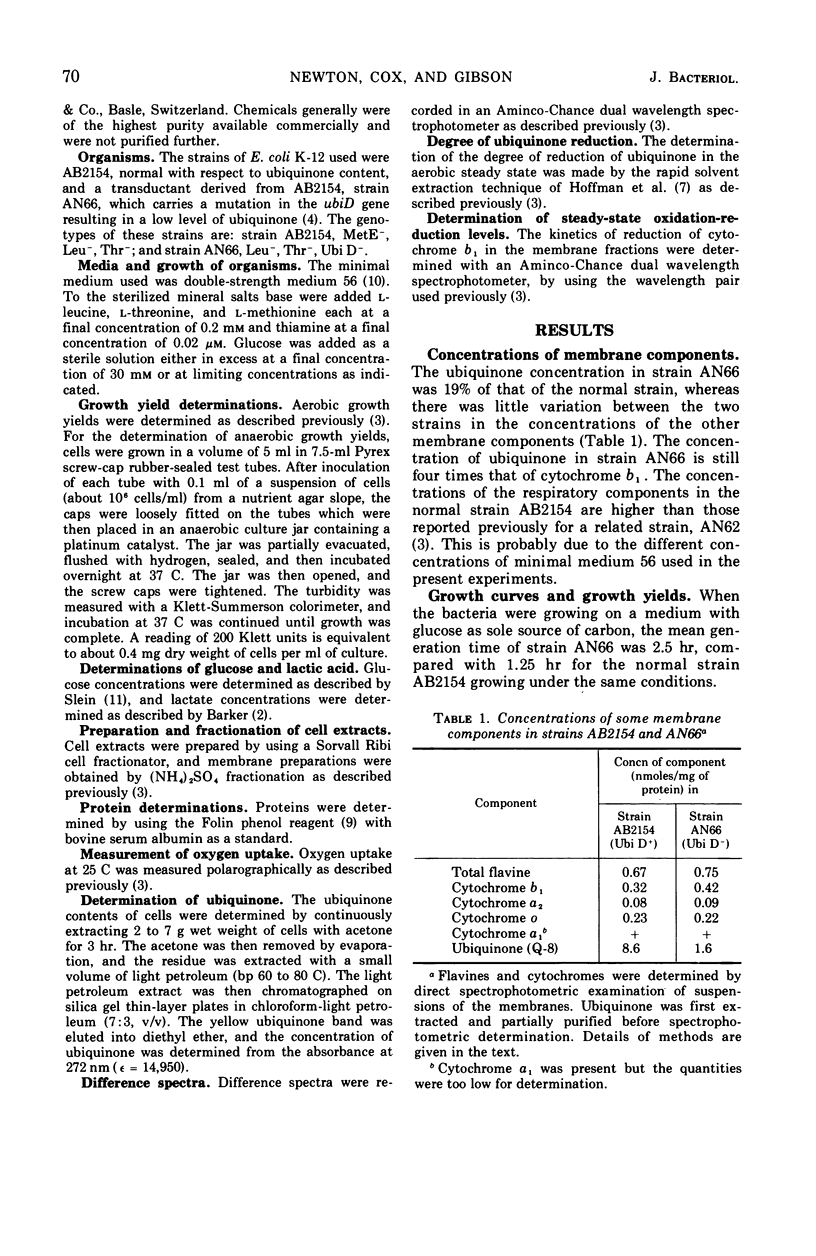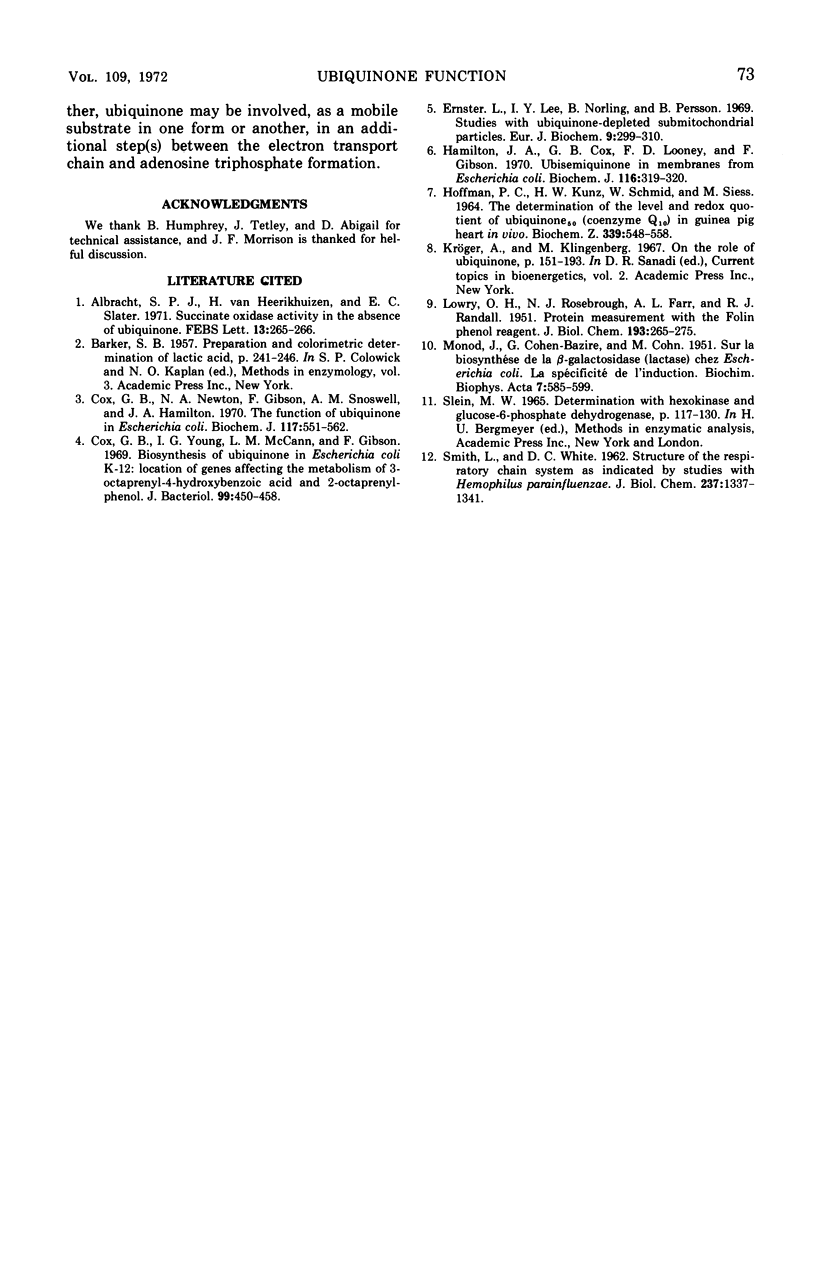Abstract
A ubiquinone-deficient mutant of Escherichia coli K-12 forming 20% of the normal amount of ubiquinone was compared with a normal strain. This lowered concentration of ubiquinone is still four times the concentration of cytochrome b1. The mutant strain grew more slowly than the normal strain on a minimal medium with glucose as sole source of carbon and gave a lower aerobic growth yield than the normal strain. The reduced nicotinamide adenine dinucleotide (NADH) oxidase rate in membranes from the mutant strain was 40% of the oxidase rate in membranes from the normal strain, and the percentage reduction of cytochrome b1 in the aerobic steady state, with NADH as substrate, was increased in membranes from the mutant strain. It is concluded that ubiquinone is required for maximum oxidase activity at the relatively high concentration (27 times that of cytochrome b1) found in normal cells. The results are discussed in relation to a scheme previously advanced for ubiquinone function in E. coli.
Full text
PDF




Selected References
These references are in PubMed. This may not be the complete list of references from this article.
- Albracht S. P.J., Van Heerikhuizen H., Slater E. C. Succinate oxidase activity in the absence of ubiquinone. FEBS Lett. 1971 Mar 22;13(5):265–266. doi: 10.1016/0014-5793(71)80236-3. [DOI] [PubMed] [Google Scholar]
- Cox G. B., Newton N. A., Gibson F., Snoswell A. M., Hamilton J. A. The function of ubiquinone in Escherichia coli. Biochem J. 1970 Apr;117(3):551–562. doi: 10.1042/bj1170551. [DOI] [PMC free article] [PubMed] [Google Scholar]
- Cox G. B., Young I. G., McCann L. M., Gibson F. Biosynthesis of ubiquinone in Escherichia coli K-12: location of genes affecting the metabolism of 3-octaprenyl-4-hydroxybenzoic acid and 2-octaprenylphenol. J Bacteriol. 1969 Aug;99(2):450–458. doi: 10.1128/jb.99.2.450-458.1969. [DOI] [PMC free article] [PubMed] [Google Scholar]
- Ernster L., Lee I. Y., Norling B., Persson B. Studies with ubiquinone-depleted submitochondrial particles. Essentiality of ubiquinone for the interaction of succinate dehydrogenase, NADH dehydrogenase, and cytochrome b. Eur J Biochem. 1969 Jun;9(3):299–310. doi: 10.1111/j.1432-1033.1969.tb00609.x. [DOI] [PubMed] [Google Scholar]
- HOFFMANN P. C., KUNZ H. W., SCHMID W., SIESS M. THE DETERMINATION OF THE LEVEL AND REDOX QUOTIENT OF UBIQUINONE50 (COENZYME Q10) IN GUINEA PIG HEART IN VIVO. Biochem Z. 1964 Jun 16;339:548–558. [PubMed] [Google Scholar]
- Hamilton J. A., Cox G. B., Looney F. D., Gibson F. Ubisemiquinone in membranes from Escherichia coli. Biochem J. 1970 Jan;116(2):319–320. doi: 10.1042/bj1160319. [DOI] [PMC free article] [PubMed] [Google Scholar]
- LOWRY O. H., ROSEBROUGH N. J., FARR A. L., RANDALL R. J. Protein measurement with the Folin phenol reagent. J Biol Chem. 1951 Nov;193(1):265–275. [PubMed] [Google Scholar]
- MONOD J., COHEN-BAZIRE G., COHN M. Sur la biosynthèse de la beta-galactosidase (lactase) chez Escherichia coli; la spécificité de l'induction. Biochim Biophys Acta. 1951 Nov;7(4):585–599. doi: 10.1016/0006-3002(51)90072-8. [DOI] [PubMed] [Google Scholar]
- SMITH L., WHITE D. C. Structure of the respiratory chain system as indicated by studies with Hemophilus parainfluenzae. J Biol Chem. 1962 Apr;237:1337–1341. [PubMed] [Google Scholar]


